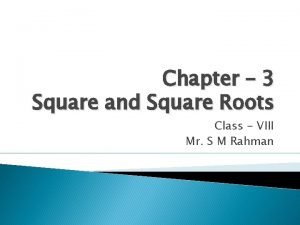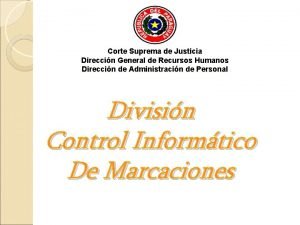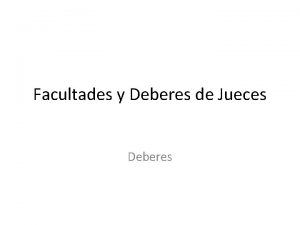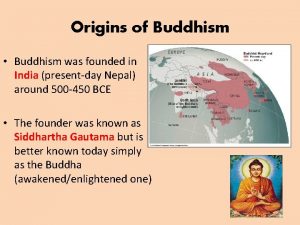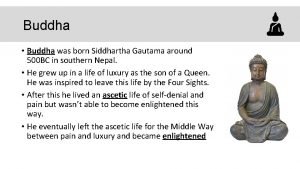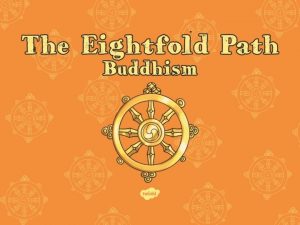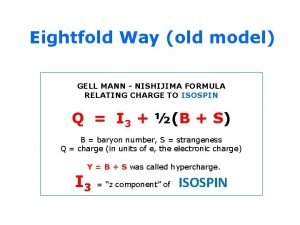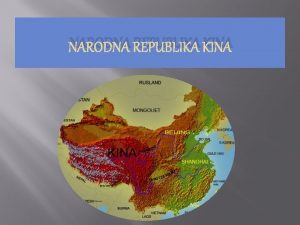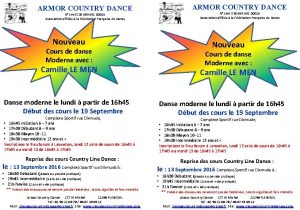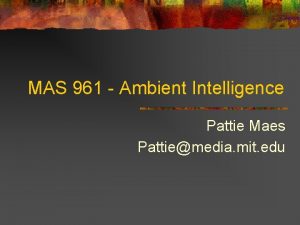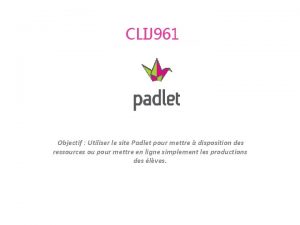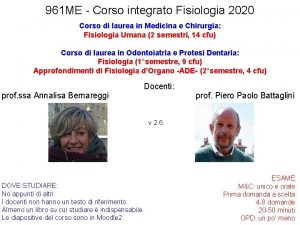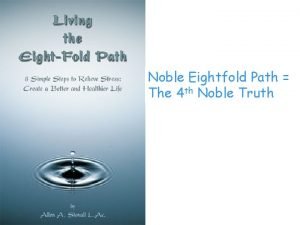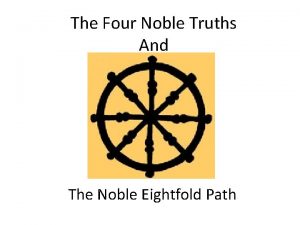1 7 THE EIGHTFOLD WAY 1 961 1




















- Slides: 20

1. 7 THE EIGHTFOLD WAY (1 961 1 964)

1. 7 THE EIGHTFOLD WAY (1 961 -1 964) • The Mendeleev of elementary particle physics was Murray Gell-Mann, who introduced the socalled Eightfold Way in 1961. (Essentially the same scheme was proposed independently by Ne’eman. ) The Eightfold Way arranged the baryons and mesons into weird geometrical patterns, according to their charge and strangeness. The eight lightest baryons fit into a hexagonal array, with two particles at the center This group is known as the baryon octet


• Notice that particles of like charge lie along the downward sloping diagonal lines: Q = +1 (in units of the proton charge) for the proton and the S +; Q = 0 for the neutron, the lambda, the S o, and the X o ; Q = -1 for the S - and the X Horizontal lines associate particles of like strangeness: S = 0 for the proton and neutron, S = -1 for the middle line and S = -2 for the two X ’s. The eight lightest mesons fill a similar hexagonal pattern, forming the ( pseudoscalar) meson octet:


• Once again, diagonal lines determine charge, and horizontals determine strangeness; but this time the top line has S = 1, the middle line S = 0, and the bottom Line S=I. (This discrepancy is a historical accident; Gell-Mann could just as well have assigned S = 1 to the proton and neutron, S = 0 to the S ’s and the L, and S = -1 to the X. ’s In 1953 he had no reason to prefer that choice, and it seemed most natural to give the familiar particles proton, neutron, and pion a strangeness of zero. After 1961 a new term hypercharge was introduced, which was equal to S for the mesons and to S + 1 for the baryons. But later developments showed that strangeness was the better quantity after all, and the word “hypercharge” has now been taken over for a quite different purpose. ) Hexagons were not the only figures allowed by the Eightfold Way; there Was also, for example, a triangular array, incorporating 10 heavier baryons the baryon decuplet:


• Now, as Gell-Mann was fitting these particles into the decuplet, an absolutely lovely thing happened. Nine of the particles were known experimentally, but at that time the tenth particle the one at the very bottom, with a charge of - and strangeness 3 was missing: No particle with these properties had ever been detected in the laboratory. Gell-Mann boldly predicted that such a particle would be found, and told the experimentalists exactly how to produce it. More over, he calculated its mass and its lifetime, and sure enough, in 1964 the famous omega-minus particle was discovered, precisely as Gell-Mann had predicted (see Fig. 1. 10).


• Since the discovery of the omega-minus (W-), no one has seriously doubted that the Eightfold Way is correct. * Over the next 10 years, every new hadron found a place in one of the Eightfold Way supermultiplets. Some of these are shown in Figure 1. 11 (This is not to say there were no false alarms; particles have a way of appearing and then disappearing. Of the 26 mesons listed on a standard table in 1963, 19 were later found to be spurious!) In addition to the baryon octet, decuplet, and so on, there exist of course an antibaryon octet, decuplet, etc. , with opposite charge and opposite strangeness. However, in the case of the mesons, the antiparticles lie in the same supermultiplet as the corresponding particles, in the diametrically opposite positions. Thus the antiparticle


1. 8 THE QUARK MODEL (1964)

• But the very success of the Eightfold Way begs the question: Why do the hadrons fit into these curious patterns? The Periodic Table had to wait many years for quantum mechanics and the Pauli exclusion principle to provide its explanation. An understanding of the Eightfold Way, however, came already in 1964, when Gell-Mann and Zweig independently proposed that all hadrons are in fact composed of even more elementary constituents, which Gell-Mann called quarks. The quarks come in three types (or “flavors”), forming a triangular “Eightfold-Way” pattern:



• The quark model asserts that • 1. Every baryon is composed of three quarks (and every antibaryon is composed of thre antiquarks). • 2. Every meson is composed of a quark and an antiquark. • With these two rules it is a matter of elementary arithmetic to construct the baryon decuplet and the meson octet. All we need to do is list the combinations of three quarks (or quark- antiquark pairs), and add up their charge and strangeness:


• Notice that there are 10 combinations of three quarks. Three u's, for instance , At Q=2/3 each, yield a total charge of +2, and a strangeness of zero. This is the A++ particle. Continuing down the table, we find all the members of the decuplet ending with the W, which is evidently made of three s quarks. A similar enumeration of the quark- antiquark combinations yields the meson table:


• But wait! There are nine combinations here, and only eight particles in the meson octet. The quark model requires that there be a third meson (in addition to the p 0 and the h) with Q = 0 and S = 0. As it turns out, just such a particle had already been found experimentally -the h’.
 The middle way
The middle way Square root of 1/961
Square root of 1/961 Acordada 961/15
Acordada 961/15 Numberblocks 961
Numberblocks 961 Deberes de un juez
Deberes de un juez Buddhism beliefs
Buddhism beliefs Eightfold path
Eightfold path Eightfold path of buddhism in hindi
Eightfold path of buddhism in hindi 3 marks of existence
3 marks of existence Eightfold path
Eightfold path Eightfold path
Eightfold path Buddhist eightfold path
Buddhist eightfold path Importance of asana
Importance of asana Buddhist eightfold path
Buddhist eightfold path Buddhist eightfold path
Buddhist eightfold path Eightfold path
Eightfold path Talk this way
Talk this way What is a threaded binary tree traversal?
What is a threaded binary tree traversal? Pengertian two way anova
Pengertian two way anova Perbedaan two way anova dan one way anova
Perbedaan two way anova dan one way anova Conventional software engineering
Conventional software engineering

